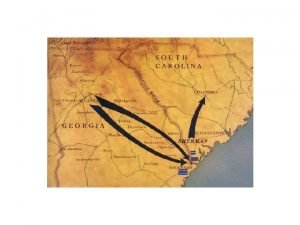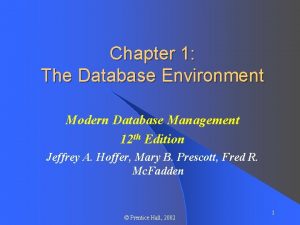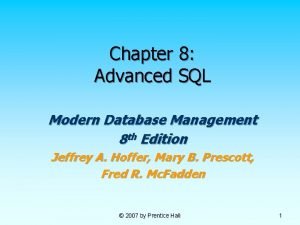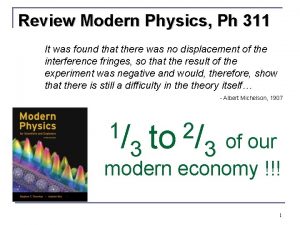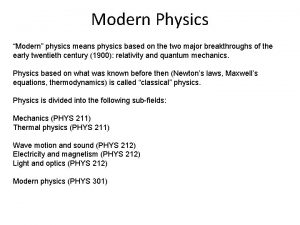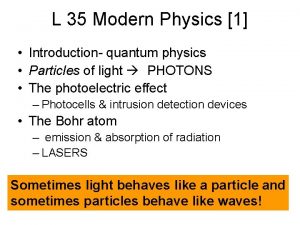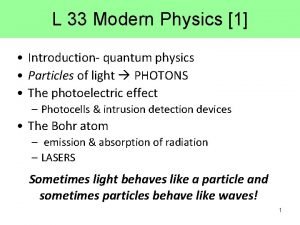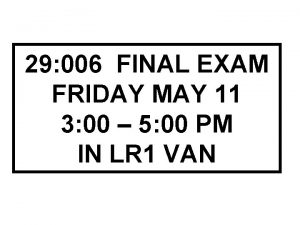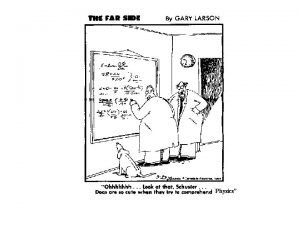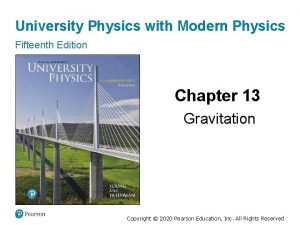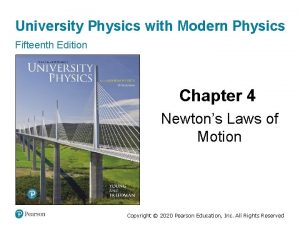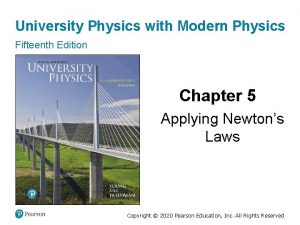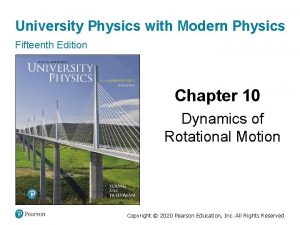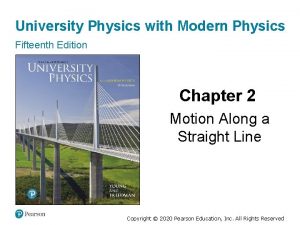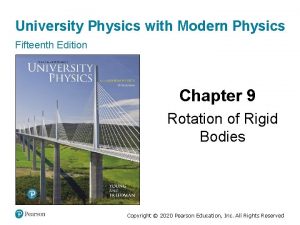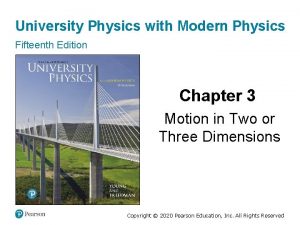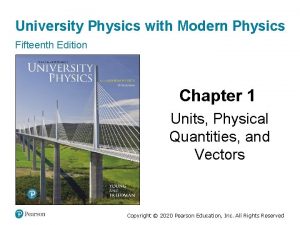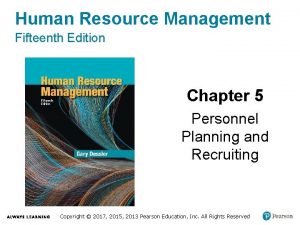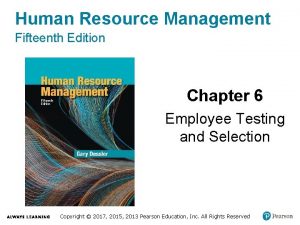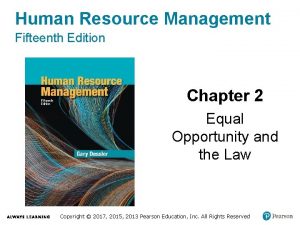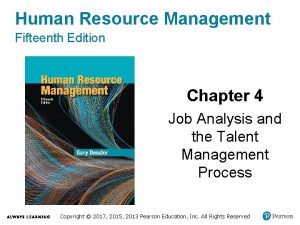University Physics with Modern Physics Fifteenth Edition Chapter

































- Slides: 33

University Physics with Modern Physics Fifteenth Edition Chapter 12 Fluid Mechanics Copyright © 2020 Pearson Education, Inc. All Rights Reserved

Learning Outcomes In this chapter, you’ll learn… • the meaning of the density and pressure of a fluid, and how they are measured. • how to calculate the buoyant force that a fluid exerts on an object immersed in it. • how to use Bernoulli’s equation to relate pressure and flow speed at different points in certain types of flow. • the significance of laminar versus turbulent fluid flow, and how the speed of flow in a tube depends on the tube’s size. • how viscous flow and turbulent flow differ from ideal flow. Copyright © 2020 Pearson Education, Inc. All Rights Reserved

Introduction • A colorful tail-spot wrasse is about 10 cm long and can float in the ocean with little effort. • A manta ray is more than 5 m across and must “flap” its fins continuously to keep from sinking. • The differences have to do with fluid mechanics. • We begin with fluids at rest and then move on to the more complex field of fluid dynamics. Copyright © 2020 Pearson Education, Inc. All Rights Reserved

Density (1 of 2) • An important property of any material, fluid or solid, is its density, defined as its mass per unit volume. • A homogeneous material such as ice or iron has the same density throughout. • For a homogeneous material, • The SI unit of density is the kilogram per cubic meter Copyright © 2020 Pearson Education, Inc. All Rights Reserved

Density (2 of 2) • Here are two objects with different masses and different volumes, but the same density. Copyright © 2020 Pearson Education, Inc. All Rights Reserved

Densities of Some Common Substances Material Densitykilograms per cubic meter Air (1 atm, 20 degrees Celsius) 1. 20 ✕ 100 Ice 0. 92 times 10 cubed Water 1. 00 times 10 cubed Blood 1. 06 times 10 cubed Aluminum 2. 7 times 10 cubed Lead 11. 3 times 10 cubed Gold 19. 3 times 10 cubed Copyright © 2020 Pearson Education, Inc. All Rights Reserved

Pressure in a Fluid • A fluid exerts a force perpendicular to any surface in contact with it, such as a container wall or an object immersed in the fluid. • Consider a small surface of area d. A within a fluid at rest, centered on a point in the fluid. • We define the pressure p at that point as: • The SI unit of pressure is the pascal, where Copyright © 2020 Pearson Education, Inc. All Rights Reserved

Pressure • Here are the forces acting on a small surface within a fluid at rest. Copyright © 2020 Pearson Education, Inc. All Rights Reserved

Pressure Is a Scalar Quantity Copyright © 2020 Pearson Education, Inc. All Rights Reserved

Pressure at Depth in a Fluid (1 of 2) • The pressure at a depth h in a fluid is greater than the pressure p 0 at the surface: • Video Tutor Solution: Example 12. 4 Copyright © 2020 Pearson Education, Inc. All Rights Reserved

Pressure at Depth in a Fluid (2 of 2) • Each fluid column has the same height, no matter what its shape. Video Tutor Demonstration: Water Level in Pascal’s Vases Copyright © 2020 Pearson Education, Inc. All Rights Reserved

Pascal’s law • Pressure applied to an enclosed fluid is transmitted undiminished to every portion of the fluid and the walls of the containing vessel: Copyright © 2020 Pearson Education, Inc. All Rights Reserved

Absolute Pressure and Gauge Pressure • When we say that the pressure in a car tire is “ 32 psi” (2. 2 × 105 Pa), we mean that it is greater than atmospheric pressure by this amount. • The total pressure in the tire is greater by patm. • The excess pressure above atmospheric pressure is usually called gauge pressure. • The total pressure is called absolute pressure. • If the pressure is less than atmospheric, as in a partial vacuum, the gauge pressure is negative. Copyright © 2020 Pearson Education, Inc. All Rights Reserved

Pressure Gauges • This Bourdon-type pressure gauge is connected to a high-pressure gas line. • The gauge pressure shown is just over 5 bars Copyright © 2020 Pearson Education, Inc. All Rights Reserved

Blood Pressure • Blood-pressure readings, such as 130/80, give the maximum and minimum gauge pressures in the arteries, measured in “mm Hg” or “torr. ” • Blood pressure varies with vertical position within the body. • The standard reference point is the upper arm, level with the heart. Copyright © 2020 Pearson Education, Inc. All Rights Reserved

Archimedes's Principle: Proof Step 1 Copyright © 2020 Pearson Education, Inc. All Rights Reserved

Archimedes's Principle: Proof Step 2 Copyright © 2020 Pearson Education, Inc. All Rights Reserved

Archimedes's Principle • An object immersed in water seems to weigh less than when it is in air. • When the object is less dense than the fluid, it floats. • The human body usually floats in water, and a helium-filled balloon floats in air. • These are examples of buoyancy, a phenomenon described by Archimedes’s principle: ‒ When an object is completely or partially immersed in a fluid, the fluid exerts an upward force on the object equal to the weight of the fluid displaced by the object. • Video Tutor Demonstration: Weighing Weights in Water Copyright © 2020 Pearson Education, Inc. All Rights Reserved

Surface Tension (1 of 2) • The surface of the water acts like a membrane under tension, allowing this water strider to “walk on water. ” Copyright © 2020 Pearson Education, Inc. All Rights Reserved

Surface Tension (2 of 2) • A molecule at the surface of a liquid is attracted into the bulk liquid, which tends to reduce the liquid’s surface area. Copyright © 2020 Pearson Education, Inc. All Rights Reserved

Fluid Flow (1 of 2) • The path of an individual particle in a moving fluid is called a flow line. • In steady flow, the overall flow pattern does not change with time, so every element passing through a given point follows the same flow line. • In steady flow no fluid can cross the side walls of a given flow tube. Copyright © 2020 Pearson Education, Inc. All Rights Reserved

Fluid Flow (2 of 2) • In laminar flow, adjacent layers of fluid slide smoothly past each other and the flow is steady. • At sufficiently high flow rates, the flow can become turbulent. • In turbulent flow there is no steady-state pattern; the flow pattern changes continuously. Copyright © 2020 Pearson Education, Inc. All Rights Reserved

The Continuity Equation (1 of 2) • The figure at the right shows a flow tube with changing cross-sectional area. • The continuity equation for an incompressible fluid is A 1 v 1 = A 2 v 2. • The volume flow rate is Copyright © 2020 Pearson Education, Inc. All Rights Reserved

The Continuity Equation (2 of 2) • The continuity equation helps explain the shape of a stream of honey poured from a spoon. Copyright © 2020 Pearson Education, Inc. All Rights Reserved

Bernoulli's Equation • Bernoulli’s equation is: • It is due to the fact that the work done on a unit volume of fluid by the surrounding fluid is equal to the sum of the changes in kinetic and potential energies per unit volume that occur during the flow. • Video Tutor Solution: Example 12. 7 Copyright © 2020 Pearson Education, Inc. All Rights Reserved

Why Healthy Giraffes Have High Blood Pressure • Bernoulli’s equation suggests that as blood flows upward at roughly constant speed v from the heart to the brain, the pressure p will drop as the blood’s height y increases. • For blood to reach the brain with the required minimal pressure, the giraffe’s maximum (systolic) blood pressure must be 280 mm Hg! Copyright © 2020 Pearson Education, Inc. All Rights Reserved

The Venturi Meter • The pressure is less at point 2 because the fluid flow speed is greater. Copyright © 2020 Pearson Education, Inc. All Rights Reserved

Lift on an Airplane Wing (1 of 2) • Bernoulli’s principle helps to explain how airplanes fly. Copyright © 2020 Pearson Education, Inc. All Rights Reserved

Lift on an Airplane Wing (2 of 2) • Computer simulation of air parcels flowing around a wing, showing that air moves much faster over the top than over the bottom. Copyright © 2020 Pearson Education, Inc. All Rights Reserved

Viscosity (1 of 2) • Viscosity is internal friction in a fluid. • Due to viscosity, the speed is zero at the pipe walls (to which the fluid clings) and is greatest at the center of the pipe. Copyright © 2020 Pearson Education, Inc. All Rights Reserved

Viscosity (2 of 2) • Lava is an example of a viscous fluid. • The viscosity decreases with increasing temperature: The hotter the lava, the more easily it can flow. Copyright © 2020 Pearson Education, Inc. All Rights Reserved

Turbulence • At low flow speeds, the flow of a fluid of a given viscosity is laminar. • When a critical speed is exceeded, however, the flow pattern becomes turbulent. • Video Tutor Solution: Example 12. 11 Copyright © 2020 Pearson Education, Inc. All Rights Reserved

Listening for Turbulent Flow • Normal blood flow in the human aorta is laminar, but a small disturbance such as a heart pathology can cause the flow to become turbulent. • Turbulence makes noise, which is why listening to blood flow with a stethoscope is a useful diagnostic technique. Copyright © 2020 Pearson Education, Inc. All Rights Reserved
 University physics with modern physics fifteenth edition
University physics with modern physics fifteenth edition Human resource management fifteenth edition
Human resource management fifteenth edition Human resources department structure
Human resources department structure Chapter 12 the worlds of the fifteenth century
Chapter 12 the worlds of the fifteenth century The worlds of the fifteenth century
The worlds of the fifteenth century Not a classical accompaniment of poulet maryland
Not a classical accompaniment of poulet maryland Fifteenth amendment
Fifteenth amendment Why does it happen
Why does it happen Using mis (10th edition) 10th edition
Using mis (10th edition) 10th edition Using mis (10th edition) 10th edition
Using mis (10th edition) 10th edition Modern labor economics 12th edition solution
Modern labor economics 12th edition solution Modern labor economics 12th edition pdf
Modern labor economics 12th edition pdf Modern real estate practice in pennsylvania
Modern real estate practice in pennsylvania Modern database management 12th edition ppt
Modern database management 12th edition ppt Modern database management system
Modern database management system Modern operating systems 3rd edition
Modern operating systems 3rd edition Tanenbaum structured computer organization
Tanenbaum structured computer organization Modern database management 8th edition
Modern database management 8th edition Modern systems analysis and design 7th edition
Modern systems analysis and design 7th edition Modern database management 11th edition
Modern database management 11th edition Modern labor economics 12th edition
Modern labor economics 12th edition College physics: explore and apply answers
College physics: explore and apply answers Shapiro experiment
Shapiro experiment Modern physics meaning
Modern physics meaning Mark thomson modern particle physics
Mark thomson modern particle physics Modern physics
Modern physics Modern physics introduction
Modern physics introduction Modern physics introduction
Modern physics introduction Physics
Physics Physics
Physics 沈榮麟
沈榮麟 Helsinki university physics
Helsinki university physics University physics
University physics University physics
University physics






